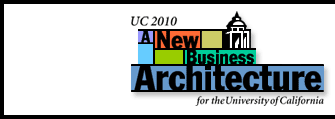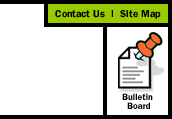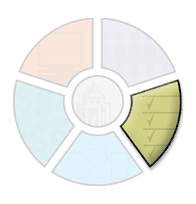 |
Business processes at the University of California reflect the complexity of our organizational structures. Processes wind circuitously through work groups and departments, each of which assumes responsibility for its specific contribution to the end result.
UC process redesign efforts over the past decade have focused on improving the performance of administrative processes by analyzing workflow; reducing hand-offs, delay intervals, process variants, and unnecessary approvals; measuring rework and elapsed times; and weighing policy constraints. Process redesign has produced benefits that are broad in scope and significant in their impact on operational effectiveness.
While the UC campuses and the Office of the President have engaged in process redesign activity in many areas within business administration and operations, not surprisingly, the financial and human resources functions have received the greatest attention.
The strategies described above, as valuable as they have proven to be in the past, will not provide the strategic breakthrough the University needs to meet the growth and complexity challenges of the future. Since the vast majority of administrative costs occur in the departments of the University, (as distinguished from central administration), improving the effectiveness of the University's business processes must begin in the departments.6 A new business model will need to do more than present users with new windows into old processes.
"Putting a Web site in front of a flawed process merely advertises its flaws — just as important as having smooth, efficient processes is being able to redesign those processes on the fly. From order fulfillment to customer service to procurement, operating processes are rarely fixed anymore. They must change their shape as markets change, as new technologies become available, as new competitors arrive." 7
Over the next decade, UC staff will fundamentally change the way they perform their work. The bureaucratic, civil service model of repetitive tasks and highly specialized staff is no longer applicable to the knowledge-based economy in which the University operates today. This report confirms the need for UC business administration and operations to transition to an information-based work environment, where staff can easily find the information they need, learn how to accomplish critical tasks and exercise the judgement necessary to perform their work.
The chart on the following page provides a general characterization of the business process environment at the University of California today. It also identifies the kinds of changes that will occur as the University increasingly associates employee productivity with better access to information, better use of technology and evolving know-how and expertise.
 |
 |
 |
 |
| UC Business Processes |
 |
| Past |
|
Future
Direction |
 |
|
Core
business processes:
| – |
Optimized to central office needs |
| – |
Are paper-driven and labor-intensive |
| – |
Are characterized by extreme complexity |
| – |
Resist delegation and simplification |
|
|
Core
business processes will:
| – |
Be
streamlined to meet campus customer needs |
| – |
Deliver
& process information in electronic format |
| – |
Focus
content delivery and application design on the departmental user |
| – |
Eliminate
costly bureaucracy |
|
|
 |
|
Processes
are designed to:
| – |
Rely
on complex procedures to ensure compliance and eliminate risk of failure
or fraud |
| – |
Address
exceptions without validating the cost and benefits of doing so |
|
|
Processes
will be designed to:
| – |
Emphasize
simplicity over excessive controls |
| – |
Accommodate
acceptable risk thresholds |
| – |
Accommodate
98% of standard transactions with exceptions handled outside of process |
|
|
 |
|
Systems supporting business processes require users to:
| – |
Learn
and use applications with no common design or user interface |
| – |
Remember a list of log-on ID's and passwords, |
| – |
Wade through information they do not (and may never) need |
|
|
A Web-based business model will allow users to create a personalized desktop in which:
| – |
Processes are presented in a series of simple, intuitive steps with templates supported by expert help |
| – |
Navigation is easy and obvious |
| – |
A single authentication/authorization is supported |
| – |
Training is integrated into the application |
| – |
The user determines what information to receive on the desktop |
|
|
 |
|
| Updating
of business processes to incorporate industry best practices occurs infrequently
|
|
UC will
keep its fingers on the pulse of changing business practices in business,
education and other industries |
|
 |
|
| UC campuses
and Office of the President share new and better ways of working on an ad
hoc basis |
|
| – |
UC business area "communities" systematically will share information and innovative business processes and practices |
| – |
Best-practices databases and other shared knowledge sources will be included in the content delivered to departmental users |
|
|
 |
|
| Organizational
barriers create obstacles to process improvement |
|
A new
business model will present content and functionality to the user that is
not restricted to departmental views and ownership |
|
 |
Policy provides institutional guidance for effective decision-making and ensures that mechanisms for regulatory compliance are embedded into business practices of the University. The University can do much to improve the maze of complexity that staff must negotiate today in order to determine what is and is not acceptable. The following table contrasts the policy challenges within UC today against the recommended changes required to support the new business model.
 |
 |
 |
| Policies
and Policy Development |
 |
| Past |
|
Future Direction |
 |
|
| Policies
are difficult for staff to locate and access |
|
UC policies
will be incorporated into business processes through decision technologies
and rule- based systems |
|
 |
|
| Policies
are overly detailed and complex. They are difficult for staff to understand
and to use as guidance in decision-making |
|
Simple
rules and "how-to's," built into applications, will guide employee
decision-making. Full text policy will be available when required via online
links to the source documents |
|
 |
|
| Policies
are often outdated and irrelevant due to infrequency of update activity |
|
| – |
Policies
will be simplified and more flexible, requiring less frequent review and
update |
| – |
Technology will automate the dissemination and updating of "how to" directories, including policy revisions |
|
|
 |
|
| Policy
development and implementation is a complicated and lengthy process |
|
UC will
reengineer the process and structure for developing and implementing policies |
|
 |
|
| Government
regulatory compliance requirements inhibit policy simplification |
|
UC will
engage in active collaboration with government agencies to implement regulatory
reform |
|
 |
A new UC business architecture will reinvent the way faculty, staff and students accomplish administrative tasks. The Business Portal will make administrative processes and policies accessible to new and existing staff in a context that includes the necessary tools to allow them to learn and do their jobs more effectively.
The University's ability to pursue the future direction described above will also require a workplace culture characterized by recruitment and retention of appropriately skilled staff, clear definitions of roles and responsibilities, just-in- time delivery of training, effective communications and risk management within the departments.
Processes & Policies Strategies:
- Engage an external consultant to assist UC in an aggressive examination of current processes, policies and procedures for relevancy and value to the UC mission. Identify the simplest, most effective processes among UC campuses and replicate them Universitywide
- Redesign key business processes to the 80/20 rule and estimate the risk-exposure levels that need to be accommodated
- Incorporate simplified policies into the "how to" and "expert help" components of the New Business Architecture
- Delegate authority and responsibility to the most-informed level of decision-making in the organization
| 6 |
Employee Systems Initiative (ESI) Report developed by UC and PricewaterhouseCoopers. |
|
| 7 |
How Process Enterprises Really Work," Michael Hammer and Steven Stanton, Harvard Business Review, November-December, 1999 p. 118. |
|
 |




